Every year, we Filipinos are busy hosting or throwing a holiday celebration during Christmas time and New year. But now that we are all at risk because of the current pandemic, we have to consider the safest way to celebrate. Holiday gatherings with family and friends who do not live with you can increase the chances of getting or spreading COVID-19.
Panahon TV offers the following considerations that you can follow if you are to attend or host holiday gatherings. https://www.youtube.com/watch?v=z-AvbY6NYuI
In an effort to “build a kinder and more compassionate world,” the World Kindness Movement observes World Kindness Day on November 13 every year. It is “a day set aside to celebrate and appreciate kindness around the world.”
But how does one define kindness? This pandemic, simple acts of kindness like staying home and wearing a face mask can do a lot in curtailing the spread of the virus. Kindness can also mean getting to know something or someone beyond the general bias toward it—such as Wuhan City in Central China, which people all over the world now only know as the starting point of COVID-19. This World Kindness Day, we offer a different, kinder view of Hubei Province’s capital city.
It was once China’s capital.
From December 1926 to September 1927, Wuhan was the capital of the Kuomintang nationalist government. To create the new capital, China’s nationalist authorities merged the cities of Wuchang, Hankou, and Hanyang, from which Wuhan’s name was derived. However, the city lost its capital status when Chiang Kai-Shek established a new government in Nanjing.
It is directly related to the fall of Chinese monarchy.
The Wuhan Uprising in 1911 ended China’s last imperial dynasty, the Qing Dynasty. The success of the revolution prompted other provinces to follow, and in 1912, 18 more provinces united to form the Republic of China. The abdication of the Qing Dynasty the following month marked the end of the kingdom.

![]()
It is one of the world’s largest university towns and is a center for research.
With over one million students in 53 universities, Wuhan is considered one of the largest university towns in the world. It has 4 scientific and technological development parks, over 350 research institutes, and 1,656 high-tech enterprises.
It is referred to as the “Chicago of China.”
Chicago is a hub of transportation, which includes O’Hare, the most globally-connected airport in the US. Wuhan is similar in a sense that it offers transport to almost all parts of China. It is a center for ships and railways, with the Wuhan Railway Hub offering trips to major cities such as Beijing, Shanghai, Harbin, Chongqing, and Guangzhou.
Mulan probably lived in Wuhan.
Some theories state that Hua Mulan, the legendary female warrior and well-known “Disney Princess,” lived in the Huangpi District of Wuhan. Some even say that it is her birthplace.
Famous Places
Wuhan is a popular tourist destination with centuries-old attractions full of history, culture and astounding views.

![]()
Yellow Crane Tower
The Yellow Crane Tower was built in 223 as a watchtower for King Sun Quan’s army. The tower was destroyed and rebuilt seven times during the Ming (1368 – 1644) and Qing (1644 – 1911) Dynasties, and in 1884, it was completely destroyed in a fire.
Rebuilt in 1981, the Yellow Crane Tower stands 51.4 meters tall and consists of five floors. Interestingly, it appears the same regardless of the direction it is viewed from. Not only is it one of the most prominent towers in the south of the Yangtze River, it is also the symbol of Wuhan due to its cultural significance.
Hubu Alley
Built in 1368, Hubu Alley is known as “the First Alley for Chinese Snacks”, and has since been serving traditional Chinese breakfasts, such as hot dry noodles, beef noodles, Chinese doughnuts, and soup dumplings. From the Yellow Crane Tower, it can be reached 20 minutes by foot.

![]()
East Lake Scenic Area
The East Lake can be found on the Yangtze River’s south bank and in Wuchang’s east suburb. Covering an area of 87 square kilometers, it is the largest lake within a Chinese city. The area is “formed from many famous scenic spots along the bank,” and attracts many tourists due to its scenery.
Well-known Food and Dishes
Wuhan’s local food is said to be a mix of the cuisines of Sichuan, Chongqing, and Shanghai, which make it “spicy yet full of flavor.” Here are three of its most famous eats:
Hot Dry Noodles (Reganmian)
This is Wuhan’s most famous dish and the first one that locals will mention. The dish, which is essentially “dry noodles mixed with sesame paste, shallots and spicy seasoning,” is eaten for breakfast and as a snack.

![]()
Doupi
Often sold as a street snack, doupi’s layers are either made of tofu skin or “pancake lookalikes”. Glutinous rice is combined with usually no more than three ingredients chosen from beef, egg, mushrooms, beans, pork, or bamboo shoots stuffed in between the layers. Once everything is assembled, doupi is pan-fried, making it crispy on the outside and soft in the inside.
Mianwo
Though donut-shaped, mianwo is salty—made of rice milk, soybean milk, scallions and salt.

Wuhan’s Downside
Even with its must-see scenery and mouth-watering dishes, Wuhan, just like any other place, is not perfect.
Crowds and traffic jam
With a population of around 11 million, Wuhan has the densest population in Central China and is the 9th most populous city in the country. Large crowds, traffic congestions, and long lines are unavoidable in the city.
Before the East Lake became the picturesque spot that it is today, it suffered from soil, water, noise, and air pollution for decades. Wuhan used to be a major manufacturing site, causing the lake’s water quality to be very poor, with outbreaks of blue-green algae and dead fish. However, through the years, its water quality has dramatically improved. Because of this, East Lake is now able to host swimming contests, and serves as one of the best attractions in the city.
Waste concerns
In 2019, street protests were carried out in Yangluo of the Xinzhou District by around 10,000 local residents rallying against the construction of the Chenjiachong waste-to-energy plant – an incinerator that the government planned to construct to handle the city’s waste. But the incinerator was said to emit cancer-inducing toxins, and was going to be built only 800 meters away from residences.
The Xinzhou District government tried to calm protesters down by assuring them that their voices will be heard in the decision-making process. However, reports said that government officials and the police went door-to-door to force residents to sign the project’s consent form, threatening them if they refused to do so.
From its cultural and historical prominence to its contributions to technological innovation, there is clearly more to Wuhan than just the coronavirus. Like any other city, it has its strengths and imperfections worth learning about especially during the pandemic and World Kindness Day.
The pandemic’s global economic impact is undeniable. According to a World Bank publication last June, the world’s gross domestic product (GDP), which determines economic health, is forecast to contract by 5.2%. Meanwhile, the Asian Development Bank predicts the Philippine economy to shrink by 7.3% this year.
Filipino employees suffered, with 46% of them—equivalent to more than 27 million—losing their jobs during the pandemic, according to the Social Weather Stations (SWS) survey.
With people scrambling to survive and earn a living, we gathered wise words from a sector of society that used to get the short end of the financial stick, but through the years, have proven their monetary smarts—the women.
Pinay Financial Power
For centuries, women all over the world have been deprived of opportunities for education, political empowerment, health and economic development. But in recent years, Filipino women have been faring better. According to the World Economic Forum’s Global Gender Gap Reports in 2017, the Philippines was the only Asian nation and developing country included in the top 10 countries that promoted gender equality.
An article from the Alliance for Financial Inclusion considers culture as a driving force for female empowerment. In the Philippines, household budgets and finances are usually managed by the women. Interestingly, in 2012, the Philippine Statistics Authority reported that female-headed households enjoyed an income of 1.2% more than the households led by men, the former having annual savings of 3.2% more than the latter. In 2008, the Functional Literacy, Education and Mass Media Survey stated that financial literacy among Filipino women is higher (88.7%) than the men’s (84.2%).
 Deliza leaving for a business trip a year before the pandemic
Deliza leaving for a business trip a year before the pandemic
Hit by the Pandemic
Since 2004, Deliza Ridoloso has been managing a successful products-and-services business that caters to the banking industry. “Before COVID-19, we were reaching the height of our consolidated revenues,” she shares. “When ECQ [enhanced community quarantine] hit, we lost 85% of our revenues. At least we had 15% left; it was better than nothing. But getting that 15% was a lot of hard work.”
For Lala Javier-Rosales, mother of two, the pandemic was a wake-up call. As the one in charge of dispatching foreign volunteers for a Japanese governmental agency that provides assistance in the Philippines, she feared for her job. “Since all the volunteers were recalled because of the pandemic, I thought my employers would let me go. But the agency’s president assured us that we would keep our jobs.” Though she was retained, Lala realized that nothing was ever really certain. “Before, I felt so secure in my job. I earned decent pay, and I was planning to rely on my work until I retired. But now, I realize that I need to be prepared for unplanned situations.”
 Lala hosting a company event
Lala hosting a company event
Rapid Adjustment
Deliza’s company managed to continue operations despite the changing quarantine categories in Metro Manila. This, Deliza attributes to their business continuity plan, which the management team began back in 2008. “Our business continuity plan was for earthquakes and floods, and not really a pandemic. But because we were already getting news of the virus in January, and started hearing of lockdowns in other countries, we started tweaking our plan.”
Deliza admits that back then, they didn’t know that a pandemic was about to happen. Still, they held emergency meetings twice a week to prepare for the virus in case it hit Manila. “For more than a decade, we’ve been saving documents in cloud storage and an off-site server. What we prepared for at that time was for disasters like earthquakes and fires. But the plan was also applicable when ECQ was declared and we couldn’t get to the office.” The plan also included protocol for people working from home, and health monitoring. “From the beginning, we already made our own health checklist based on information from WHO (World Health Organization).
Because Deliza’s company offers business-to-business products, they beefed up their remote marketing strategy. “This was where our 15% revenues came from. We had to adapt right away. We did video conferencing. Because we couldn’t meet face-to-face with our clients, we had our presentations on Zoom. We worked on our digital marketing to make sure our presentations were clear. Communication was important— with our clients, our staff, our suppliers.” Her management team met as often as twice a day via Zoom. “The situation kept on changing at the end of the day. When I think about it now, it sounds a little excessive? But it wasn’t because we were working so hard to continue operations remotely. We had to re-engineer our processes.”
At the start of the lockdown, working from home allowed Lala to re-assess her family’s finances. “I had time to reflect. Before the pandemic, I had an essential oils business that I wasn’t really taking seriously. From time to time, I’d share about it on my Facebook page, but I wasn’t conscientious about it.” Since the pandemic, Lala has become more vocal and intentional about her business. “I truly love essential oils, and the more I shared about it, more people signed up under me until my business grew. It came to a point where I started earning more from it than from my day job.”
Another earning opportunity came to Lala because of her love for food. “Food is my stress-reliever. And because me and my husband hail from Batangas, we found ourselves missing the delicacies there.” When the couple secured a travel pass, Lala offered to buy Batangas delicacies for her interested friends. “I’d post the announcement and food photos on my Facebook wall. That side business augmented our family income. It was a great feeling to make other people happy through food.”
 Deliza (2nd from right) with university students
Deliza (2nd from right) with university students
Present Scenario
Up until June, Deliza’s company managed to keep all their approximately 100 employees. But eventually, some were let go. “We tried to give them the best arrangement we could afford. We allowed them to use up their sick and vacation leaves so they’d still get paid. One of our managers who was a senior citizen got the retirement package, which we give in monthly installments.”
Revenues have picked up in September, but Deliza says cash flow continues to be tight. To keep other employees, their work hours were cut down, along with their pay. “At the end of the year, we aim to break even at the minimum. We’re trying our best to keep all our people and not have any more layoffs. So we’re trying to keep costs covered while operating as best as we can.”
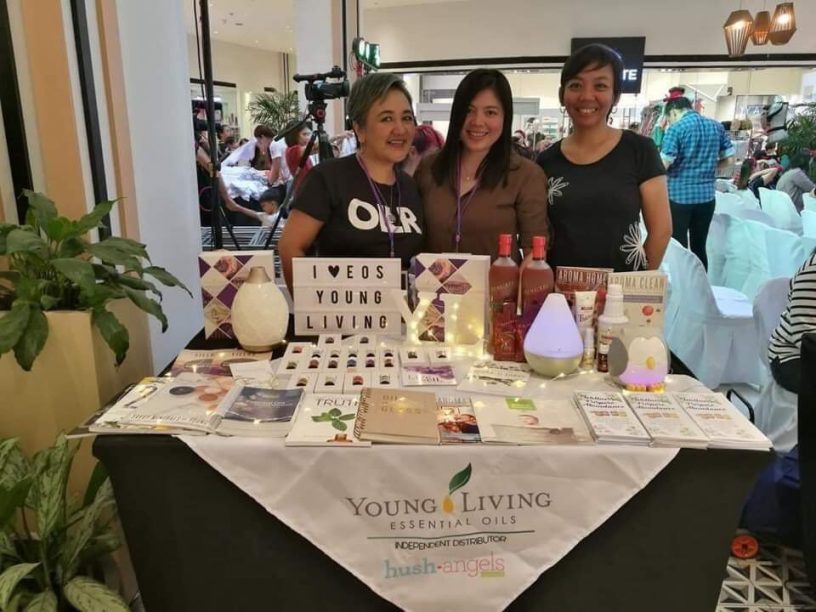 Lala (right) and her essential oil business
Lala (right) and her essential oil business
Financial Survival Tips
Survival depends hugely on preparedness. Deliza and Lala share the insights they have gathered during the pandemic.
Be informed. “Being aware of global current events gave us an idea of what’s going to happen in case Manila was put under lockdown. Being on top of the news is very important,” says Deliza. “We were being observant, and prepared in our own way.”
Never be complacent. Because of the pandemic, Lala learned that it’s vital to have multiple income streams. “Aside from side businesses, my husband has also become more involved in their Batangas farm. We want to grow our own food, and maybe eventually, earn from it.” In choosing side businesses, Lala advises to “find something you’re passionate about. Turn your passion and talent into something income-generating.”
Work on a business continuity plan. “I believe that every business should have a continuity plan in case of emergencies,” says Deliza. “It’s a lot of work because it has to tailor-fit your operations. It’s not a template you can pull out a book; you have to make it your own. Every year, we refine our business continuity plan.”
Maintain a good relationship with banks. “We have bank loans, and luckily, we’re able to meet our responsibilities with them. If you can’t pay them, then you shouldn’t run. You need to talk to the banks, and discuss what you can do.” Deliza also shares her company’s golden rule: Don’t borrow money for something consumable. “We make loans to make purchases for our goods we plan to sell, not those we already sold. We borrow money to make money, so we can pay back our loans.
Set goals. Outlining goals is also a sign of preparedness. “Our team talks about our financial goals, about what we need to target to keep as many people as we can, and keep the company healthy.” Lala’s latest goal is to secure a critical-health insurance for her family. “My father-in-law was recently hospitalized and he shelled out a huge amount of money. If that were to happen to my family, I wouldn’t know where to get the cash.”
Gain support. While Lala’s network of friends was instrumental in growing her side businesses promoted through social media, Deliza finds that being part of a business organization helped validate her company’s steps in surviving the pandemic. “Being part of a business group helped boost my confidence and knowledge on how we should do things. It gave me a better understanding of best practices.”
The pandemic may be far from over, but these women will continue to do their best to weather the financial storm. “I have no plans of resigning, and I aim to further grow my businesses,” Lala declares. Deliza stresses the importance of taking the time to prepare for possible outcomes. “If you’re leading your company, you should have a clear vision. You need to go to a quiet place and meditate and think about scenarios. You really need to adapt if you want your business to survive.”
During this pandemic, death has become a daily update. As of writing, COVID-19 has caused nearly 900,000 deaths across the world, while the Philippines reports 3,890 fatalities.
But these numbers don’t reflect the bigger picture of deaths during the pandemic. According to Our World in Data, the term “excess mortality” refers to the number of deaths beyond normal situations, showing the mortality impact of the pandemic. These “excess deaths” may be related to the following:
- Deaths that occurred at home since some countries only report COVID-19 deaths in hospitals
- Untested individuals since some countries only report COVID-19 deaths with confirmed tests
- Poor death-reporting systems
- Deaths from other causes, but were still impacted by the pandemic because of the strain on healthcare systems, fewer people going out of their homes to get treatment, and less financial means to seek treatment
Last June, when the global death toll from COVID-19 was still below 500,000, BBC reported that on top of this number, at least 130,000 more people have died during the pandemic. Mortality data from 27 countries showed that overall deaths are beyond average even when the virus has been factored in. For example, in Jakarta in Indonesia, deaths were 55% higher than usual, resulting in 4,700 more deaths not directly caused by COVID-19 from March to May.
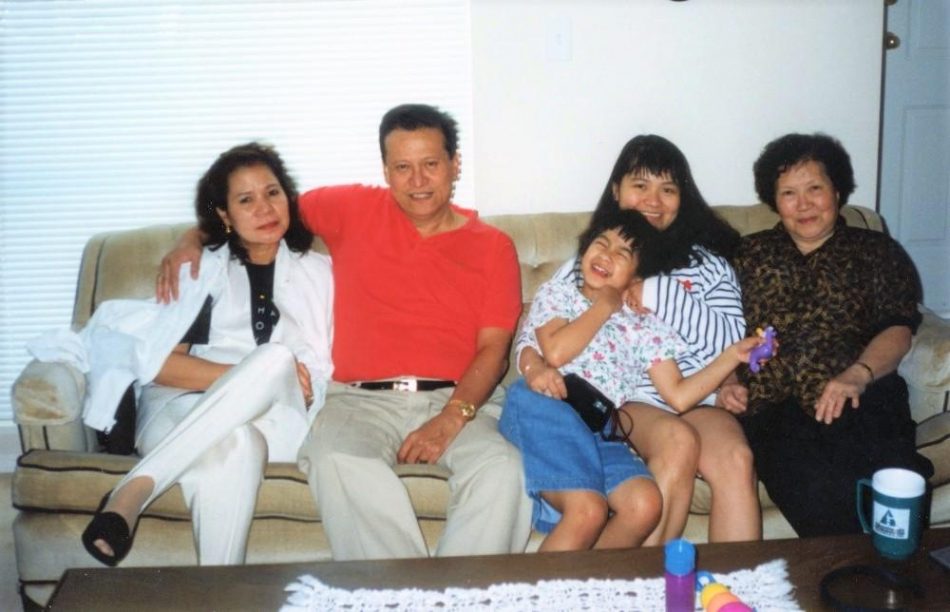 Rachelle’s Uncle Ric (in red) during happier, healthier days. Rufina (far right), passed away only 2 weeks after her brother Ric.
Rachelle’s Uncle Ric (in red) during happier, healthier days. Rufina (far right), passed away only 2 weeks after her brother Ric.
Tales of Loss
Rachelle’s experience on recent family deaths seems to confirm the “excess deaths” happening all over the world. “In the span of less than two months, I lost my uncle, my aunt, a cousin, and a grandparent—not from COVID-19, but from the fact that they all had underlying illnesses. Because of the pandemic, it was quite hard to get treatment and immediately get admitted to a hospital,” she shares. “The sheer number of daily announcements on social media I read from friends who’ve lost their loved ones is mind-boggling and devastating.”
Rachelle’s Uncle Ric, who she confides was like a second father to her, learned he had cancer early this year. Though he received chemotherapy and other required treatments, the lockdown made it difficult for him to visit the hospital. Eventually, they found a doctor from a nearby clinic who could administer treatments. Still, Rachelle’s uncle passed away last month. “The speed of his deterioration was quite a shock to everyone. It’s as if the lockdown sped it up. It seemed that the difficulty of getting treatment, getting a hospital room, and the overall isolation from loved ones really exacerbated his illness.”
For Gerry, this pandemic marks the passing of his best friend Don, who initially complained of a sore throat and difficulty in breathing. “He was initially diagnosed with an infection of the throat—an abscess. To prevent the spread of the infection, he was intubated. The day after, some complications happened and his infection became sepsis. He went into cardiac arrest and then into a coma. He flatlined for 15 minutes but was revived and was placed on a ventilator. His swab test for COVID-19 was negative so he was administered heavy doses of antibiotics. A week later, he passed away.”
Karen, who had her first pregnancy before the pandemic, was excited to raise a child with her husband. Because of her delicate pregnancy, she was confined to bed rest, finally getting the clearance to move around in early May. But during her 21st week of pregnancy in June, her husband was hospitalized due to an undiagnosed heart problem. “Because of COVID-19, the hospital we went to was very strict. Once companions entered the hospital, they couldn’t leave until the patient was discharged. We didn’t have anyone to stay with my husband, so against my doctors’ initial wishes, I stayed. That same evening, we found out that my mother, who works overseas, contracted COVID-19. As my husband was put on complete bed rest, I had to assist him.”
A few days later, Karen felt fluid trickling down her leg. Her obstetrician ordered her to stay in bed, but she was only able to do so after finding someone else to watch over her husband. Because she was losing amniotic fluid, Karen was confined to the hospital bed next to her husband’s. Two days later, she felt an incredible pain on her lower back, and felt something sliding down her vagina. “I felt the top of our baby’s soft, tiny head on the palm that I had been holding against my vagina, as if that would close it up. I screamed for my husband, for the nurse. Our baby had mostly slid out of me by then, but I cradled the baby ever so gently as he was still partly inside. I had an instance of clarity as the nurse came in. It was over. Our baby was gone.”
 Gerry, 2nd from left; and his best friend Don in green, center (Photo by Joy Galang)
Gerry, 2nd from left; and his best friend Don in green, center (Photo by Joy Galang)
Anatomy of Grief
According to psychologist Roselle G. Teodosio, owner of IntegraVita Wellness Center, grief prevails during the pandemic. “Grief comes in many forms,” she explains. “It is not just about losing a loved one, but an ending to something. It may be work, home, lifestyle, relationships, connections—basically losing something familiar or significant to us.”
To better understand grief, Teodosio shares its different kinds:
- Anticipatory grief is the feeling of loss even before the death actually happens. “If a loved one is diagnosed with a terminal illness, grief can creep in without you recognizing it. It can also mean guilt on the part of the griever because it’s equivalent to giving up hope. But this can also lessen the impact of the actual pain after the person passes because it was expected.”
- With common grief, people carry on with their daily routine without showing much pain. “People would often misinterpret the actions of the griever as someone who was not affected by the loss. But acute feelings of grief may come in ‘bursts’ not observed by others unless they are with the griever 24/7.”
- Complicated grief is so overwhelming that the griever may find it difficult to function. “The pain may be debilitating that the person can have irrational thoughts that can lead to self-harm or mental illness— if not given the proper care and support,” Teodosio warns.
- Delayed grief does not appear immediately after the loss, its full impact felt months after the event. “This is more common when there is another grief or significant change that happens in a person’s life,” Teodosio states. “It happens when the griever sets aside her feeling to focus on a more pressing situation.”
- Inhibited grief is when person is in denial or refuses to face reality. “They usually distract themselves in the hope that they can avoid the pain. This may lead to exhaustion and can cause chronic physical pain.”
- Exaggerated grief, similar to the complicated grief, may come when the person has experienced two or more losses within a period of a few weeks or months. “The griever may be unable to cope with the losses since there is little or no time to process each loss. This may lead to depression or anxiety or other mental illnesses if not given proper attention.”
 Gerry (in blue, center) and Don (in green, right)
Gerry (in blue, center) and Don (in green, right)
Grief and the Pandemic
Teodosio states that the general feeling of loss in this time of a pandemic exacerbates the feeling of losing a loved one. Grievers may feel stretched to their limits, and any additional stress can trigger mental suffering.
When Karen lost her baby, she was a mess of emotions, unable to process the trauma until a few hours later. “Grief is a strange, shape-shifting, unforgiving monster. Loss is always vicious, no matter what, but most especially when it’s unexpected. I’ve already lost four family members that way—one day they were fine, and the next day they were gone,” she confides. “But this one was harder than I thought possible.”
Almost two months after his best friend’s death, Gerry still can’t fully function. “It’s like I want to still do the things we’ve always done together, but I have this fear that things will never be the same without him, so why bother? I listen to his Spotify playlist, and just wish that he’d still be around. I try my best to get on with life but there’s always this heartache that I feel all the time. We always did things together.”
For Rachelle, experiencing multiple deaths this pandemic has left her disoriented. “When yet another relative passed away last week, I called my Uncle to tell him, only to realize while I was dialing the phone that he was already dead,” she shares. “I think the process of grieving is distorted these days. It’s cut short, or it’s rushed or incomplete. Bodies need to be cremated within 24 hours. If it’s ECQ, wakes with even close relatives aren’t allowed. There is simply no time to grieve. And you can’t just run to a friend or loved one to seek comfort—you could infect each other and die, too. It’s terrible.”
Teodosio explains these amplified emotions: “This pandemic has upended any sense of normalcy that we felt. This loss of security and a loss of a loved one leave a person in a very vulnerable position. It can feel like we are grieving in isolation. Adding to this is the guilt from not having been able to comfort the dying loved one. No proper goodbyes, no last hug or kiss or words were shared.” Because of the pandemic, grievers don’t get the closure they need and are left in grief limbo. “One is not physically present to see the loved one take his last breath or do the rituals according to their belief. There is no sense of finality to jumpstart the grieving process,” Teodio says. “This can create chronic anxiety, chronic sorrow and even depressive symptoms.”
Gerry, who has lost his parents at different times before the pandemic, recalls the overwhelming support he and his brothers received, which helped them to pull through. “In Don’s case, I think I’ve never felt so much loneliness and isolation. It’s true that there are so many ways to keep in touch nowadays, but it’s never the same as face-to-face interaction, and someone sitting beside you and giving you words of comfort. Losing a loved one nowadays is a statistic or another name to be crossed out on your list of friends. I can’t imagine a way of living like this.”
Karen and her husband are slowly coming to terms with the loss of their child, who may have had a better chance of survival if it weren’t for the pandemic. “I did my best to rest and care for myself and the baby as the doctor ordered, but the pandemic made it difficult to go to the doctor whenever I wanted. We had planned to get a yaya for me as time went on, but quarantine restrictions meant it was almost impossible to find help right away.” Because her husband is required to be on field, Karen finds it difficult to manage her grief. “At this point, I don’t even expect to go back to my old life. I just want a life, any okay life, that doesn’t keep me trapped at home by myself. I need my husband now, of all times, and he can’t be with me because of the pandemic.”
 Rachelle and her Uncle Ric last year
Rachelle and her Uncle Ric last year
Coping with Loss
Most of us are familiar with the five stages of grief: denial, anger, bargaining, depression and acceptance. But Teodosio reiterates that one doesn’t necessarily go through these stages in a linear pattern. “There is no standard formula in dealing with grief and how to process it,” she says. “One can go back and forth between stages or even skip some of them. The sequence of the stages is just a reminder to those grieving that there is an end to the pain, and in effect ‘a light at the end of the tunnel.’” Teodosio stresses that there is no “normal” amount of time to grieve, and that a person should not be pressured into recovering just because it had been a few months or so. She offers these pointers for the grieving:
Learn to accept that grieving needs time. Grieving is a process, and acknowledging the pain is accepting one’s reality.
Talk to others. “Regardless of how hard it can be to connect with others, it is imperative that you don’t isolate yourself,” Teodosio advises. “Seek support from family and friends, or even professional help if needed.”
Practice self-care. It is important to have enough sleep, to eat well and exercise regularly. The stress of facing a loss can quickly drain you.
Try to return to your hobbies. Having activities that bring you joy will help in coping. Try to discover new hobbies to distract yourself from the sadness and loneliness.
Try writing a journal of gratitude. Amidst the negative emotions, try to remember the things to be grateful for. Even the littlest, most random things will help to refocus your attention.
Karen copes by picturing her baby as a little angel, whom she’s named Jethro. “Within the first few days of Jethro’s passing, so many things were happening, and sometimes we would ask Jethro for favors. One of those was ‘Please watch over Lola in the UAE because she is sick. Please ask God to help her get well.’ My mom developed pneumonia due to COVID-19, and had difficulty in breathing. A few days later, my mom called to say she tested negative for the first time. She believed Jethro had helped her. It was a great comfort to hear that.”
Though Gerry finds it difficult to carry on, he plans to make the rest of his life a tribute to his dear friend. “In all the things I’ll be doing in the near future, I’ll put a small piece of him just to keep him really close and keep my grief at bay. Do a few triathlons, surf waves, dive, create artworks all in his honor. But I feel that I see him in all of my friends and loved ones now. I should also remember to laugh and smile more since that’s the best way to give him tribute.
Rachelle liked like to remember her uncle as he was in his last year—funny, laidback and optimistic. “To him, the pandemic wasn’t something to worry about; he just soldiered on. I wish I had the same optimism, even during dire circumstances.”
If you’re anxious or depressed, don’t hesitate to reach out to the following:
- Roselle Teodosio (psychologist) – 09166961223 and 09088761223 or email: selteodosio@gmail.com
- National Center for Mental Health Crisis – 09178998727
- Philippine Mental Health Association – 09175652036
- Philippine Psychiatric Association – 09189424864
Australia is currently on its second wave of Coronavirus Disease (COVID-19) infection. The first COVID-19 case in Australia was reported on January 25, 2020. The number of cases in the country sharply rose in March, then declined significantly in April due to lockdowns and strict health protocols. In July, Australia saw another increase in COVID-19 cases in Melbourne, the capital of the state of Victoria. Victoria is under lockdown as of writing. However, other states like New South Wales whose capital is Sydney, are under milder restrictions. Australia is the fifth country in the world with the largest number of overseas Filipino workers. Let us take a look at the day-to-day experiences of a Filipina living in Sydney on Buhay Pandemya.
- What is coronavirus?
The coronavirus is a type of virus that causes respiratory illness in animals and humans. It is zoonotic, meaning it can be transmitted between animals and humans. The virus was first discovered during the 1960s, and was called coronavirus because of its crown-shaped structure.
As of now, there are seven types of the coronavirus that can infect humans. They range from the common cold to more severe diseases, such as the Middle East Respiratory Syndrome (MERS-CoV), Severe Acute Respiratory Syndrome (SARS-CoV), and its latest strain, the Coronavirus Disease 2019 (COVID-19).
MERS-CoV, discovered in Saudi Arabia last 2012, resulted in 858 deaths. According to scientists, this coronavirus came from camels and has flu-like symptoms. Meanwhile, SARS began in China in 2002. It was reported to have come from a civet cat, and has 8,000 confirmed cases, killing almost 800.
On January 9, 2020, the World Health Organization (WHO) reported a new strain of coronavirus, associated with an outbreak of pneumonia in Wuhan, China. Last February 11, 2020 it was renamed as the Coronavirus Disease-2019 COVID-19.
- Is COVID-19 deadly?
Just like MERS-CoV and SARS, the COVID-19 is deadly. The moment one gets infected, the virus spreads immediately to the lower respiratory tract, including the lungs. This type of coronavirus may cause severe pneumonia in 24 hours, and it cannot be cured by antibiotics.
- What are the symptoms of COVID-19?
Its respiratory symptoms include fever, cough, shortness of breath and other breathing difficulties. However, there are cases of the coronavirus disease that are asymptomatic or display no symptoms. It takes around 14 days before the symptoms appear.
- How can you protect yourself from this virus?
According to the World Health Organization, here are the ways to prevent yourself and others from getting the COVID-19:
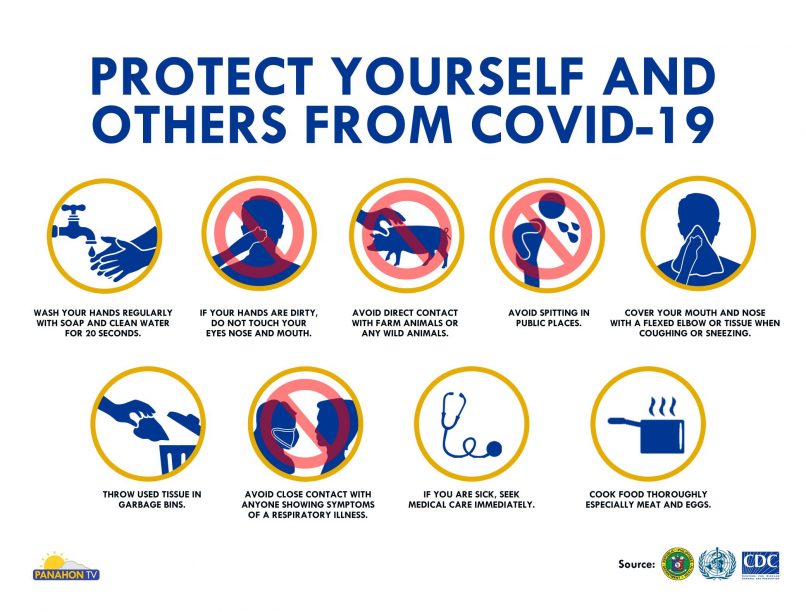
- Wash your hands regularly with soap and clean water for 20 seconds.
- If your hands are dirty, do not touch your eyes nose and mouth.
- Avoid direct contact with farm animals or any wild animals.
- Avoid spitting in public places.
- Cover your mouth and nose with a flexed elbow or tissue when coughing or sneezing.
- Throw used tissue in garbage bins.
- Avoid close contact with anyone showing symptoms of a respiratory illness.
- If you are sick, seek medical care immediately.
- Cook food thoroughly especially meat and eggs.
- What should you do if you have a scheduled travel abroad?
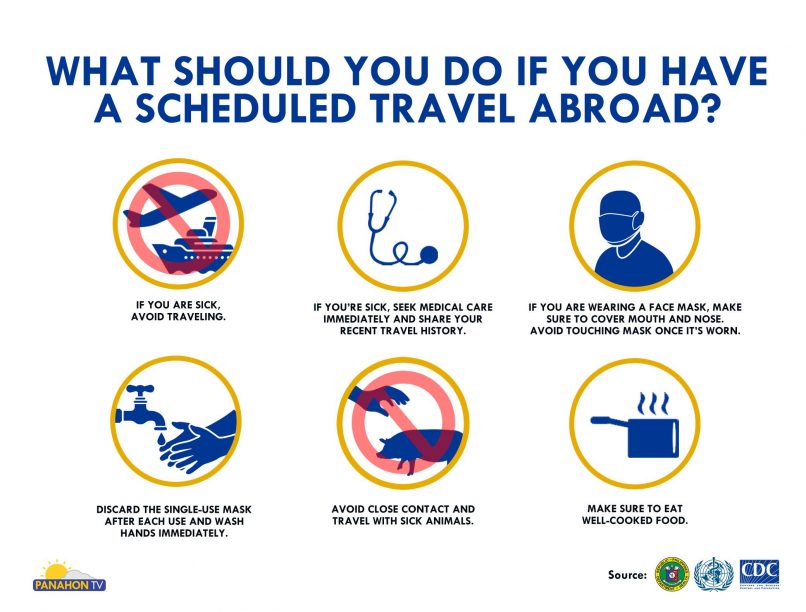
- If you are sick, avoid traveling.
- If you’re sick, seek medical care immediately and share your recent travel history.
- If you are wearing a face mask, make sure to cover mouth and nose. Avoid touching mask once it’s worn.
- Discard the single-use mask after each use and wash hands immediately.
- Avoid close contact and travel with sick animals.
- Make sure to eat well-cooked food.
- How can you cope if you’re stuck abroad and can’t go home?
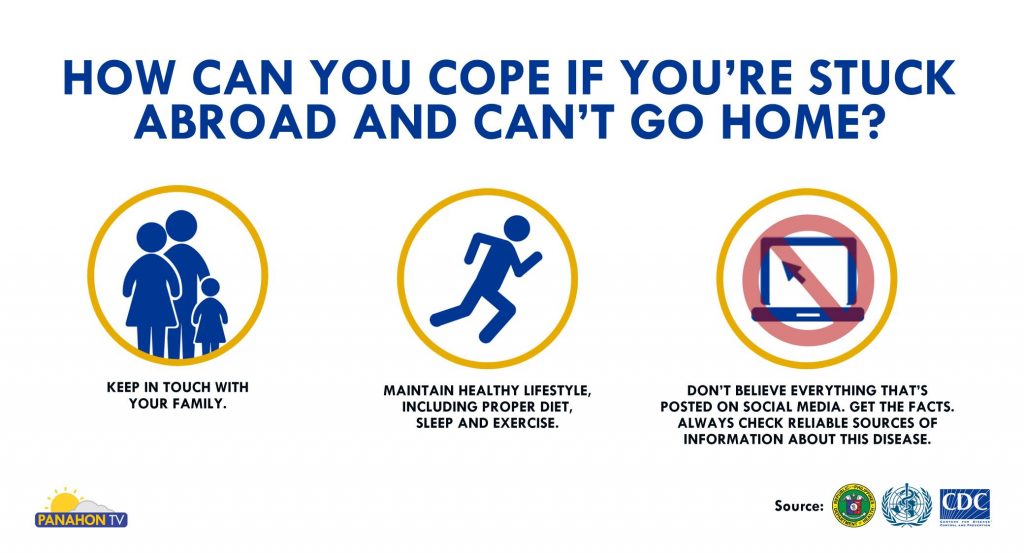
- Keep in touch with your family.
- Maintain healthy lifestyle, including proper diet, sleep and exercise.
- Don’t believe everything that’s posted on social media. Get the facts. Always check reliable sources of information about this disease.
If you need more information, please check these sources:
- Department of Health – https://www.doh.gov.ph/
- World Health Organization – https://www.who.int/
- Centers for Disease Control and Prevention https://www.cdc.gov/
